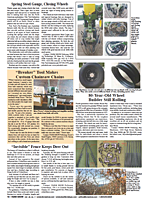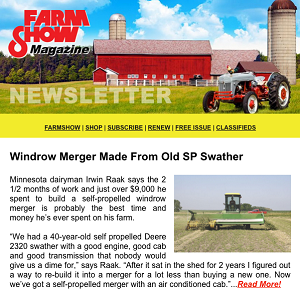Bucket Spinner Extracts Honey
Spending hundreds of dollars on a honey extractor for his few hives didn’t make sense to James Noble, so he built his own. It needed to be big enough to hold 2 standard hive frames loaded with honey (about 6 lbs. each). Using a plastic pail and an electric drill to power the spinner, he’s able to extract honey without damaging the delicate comb.
“I’m a hobby beekeeper with just 3 hives. I only need an extractor for a day or two each year,” says Noble.
To make the extractor, Noble needed a chamber, a spinner with a central rod with mounts for the frames, and a way to seat the spinner in the chamber. For the chamber, he selected a food grade 7-gal. pail. It’s slightly taller than a 5-gal. pail, but a similar diameter. He bought a 1 1/2-in. honey gate, available through beekeeping retailers for $10 to $12, and installed it over a hole cut near the bottom of the pail.
The frame spinner was made with a 36-in. long, 3/8-in. stainless steel threaded rod and frame holding boards cut from heavy-duty, white plastic cutting board stock.
“I used 3/4-in. thick stock to give the centrifuge some heft, which is helpful so the frames do not completely dominate the weight,” says Noble.
The top board is a 5 by 8-in. rectangle. The bottom board is an 8-in. hexagon. Both boards were center drilled for the rod. Two 1/2-in. sq. holes were cut out of each plate (opposite each other, not across from each other) to accept the tips of frame top bars. The holes are positioned 1 1/4 in. from the edges of the board.
Noble attached a threaded flange with 3 screws over the hole on the topside of the lower plate. Once the rod was threaded through the flange, a washer, lock washer and smooth end cap nut were attached to the end of the rod.
“The bottom board needs to be fixed in place on the rod, but the upper board needs to be easily removed to load and unload frames,” says Noble. “I put a washer, lock washer and wing nut on the rod to match the length of a frame. A second washer, lock washer and wing nut are used to secure the board when frames are in place.”
To stabilize the spinner in the pail, Noble attached a 2-in. diameter circle of cutting board stock to the bottom of the pail. He drilled a hole in the center of the bottom of the pail and through the circle. He countersunk a 1/2-in. diameter hole in the topside of the circle, shallow enough to accept a round nut. He placed a 1-in. rubber O-ring between the circle and the pail’s bottom, securing all three with a short screw and nut.
“I created a stand for the 7-gal. pail, with room underneath it for a 5-gal. pail and honey filter,” says Noble.
Two vertical 2 by 4’s on either side of the stand extend above the bucket. A removable cross bar with a hole for the spinner rod attaches to the verticals with wing nuts. The cross bar stabilizes the rod.
Once he was done, the honey frames extended out over the top of the bucket’s edge, causing honey to spatter out of the bucket when frames are spun too fast. To add height, he cut the bottom off a 5-gal. pail and slipped the top half (with its larger top diameter) into the 7-gal. pail to gain needed height.
Contact: FARM SHOW Followup, James Noble (ph 646 431-1162; demarestfarmer@gmail.com).

Click here to download page story appeared in.
Click here to read entire issue
Bucket Spinner Extracts Honey FARM HOME Miscellaneous Spending hundreds of dollars on a honey extractor for his few hives didn’t make sense to James Noble so he built his own It needed to be big enough to hold 2 standard hive frames loaded with honey about 6 lbs each Using a plastic pail and an electric drill to power the spinner he’s able to extract honey without damaging the delicate comb “I’m a hobby beekeeper with just 3 hives I only need an extractor for a day or two each year ” says Noble To make the extractor Noble needed a chamber a spinner with a central rod with mounts for the frames and a way to seat the spinner in the chamber For the chamber he selected a food grade 7-gal pail It’s slightly taller than a 5-gal pail but a similar diameter He bought a 1 1/2-in honey gate available through beekeeping retailers for $10 to $12 and installed it over a hole cut near the bottom of the pail The frame spinner was made with a 36-in long 3/8-in stainless steel threaded rod and frame holding boards cut from heavy-duty white plastic cutting board stock “I used 3/4-in thick stock to give the centrifuge some heft which is helpful so the frames do not completely dominate the weight ” says Noble The top board is a 5 by 8-in rectangle The bottom board is an 8-in hexagon Both boards were center drilled for the rod Two 1/2-in sq holes were cut out of each plate opposite each other not across from each other to accept the tips of frame top bars The holes are positioned 1 1/4 in from the edges of the board Noble attached a threaded flange with 3 screws over the hole on the topside of the lower plate Once the rod was threaded through the flange a washer lock washer and smooth end cap nut were attached to the end of the rod “The bottom board needs to be fixed in place on the rod but the upper board needs to be easily removed to load and unload frames ” says Noble “I put a washer lock washer and wing nut on the rod to match the length of a frame A second washer lock washer and wing nut are used to secure the board when frames are in place ” To stabilize the spinner in the pail Noble attached a 2-in diameter circle of cutting board stock to the bottom of the pail He drilled a hole in the center of the bottom of the pail and through the circle He countersunk a 1/2-in diameter hole in the topside of the circle shallow enough to accept a round nut He placed a 1-in rubber O-ring between the circle and the pail’s bottom securing all three with a short screw and nut “I created a stand for the 7-gal pail with room underneath it for a 5-gal pail and honey filter ” says Noble Two vertical 2 by 4’s on either side of the stand extend above the bucket A removable cross bar with a hole for the spinner rod attaches to the verticals with wing nuts The cross bar stabilizes the rod Once he was done the honey frames extended out over the top of the bucket’s edge causing honey to spatter out of the bucket when frames are spun too fast To add height he cut the bottom off a 5-gal pail and slipped the top half with its larger top diameter into the 7-gal pail to gain needed height Contact: FARM SHOW Followup James Noble ph 646 431-1162; demarestfarmer@gmail com
To read the rest of this story, download this issue below or click
here to register with your account number.








